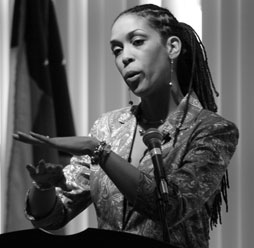By Mark Bauer/reporter
Television shows such as CSI, Without a Trace, Crossing Jordan and Forensic Files have made the world of forensics a hot commodity, a guest speaker told a room full of SE students last week.
Dr. Arthur Eisenberg of the University of North Texas Health Science Center said forensics is more than what one sees on television. He also said the field of forensics has actually been around since the mid-1980s.
“ Those shows have planted the notion in the public’s mind that police must have DNA evidence to solve a crime,” he said.
While DNA does play an important role in determining the outcome of a case, it is not the single most important factor in regard to the prosecution of criminals, Eisenberg said. Because DNA analysis has become so heavily relied upon by law enforcement agencies, various states are applying laws that mandate once someone is arrested, a DNA sample must be obtained and recorded.
DNA does not just put criminals behind bars. Thirty percent of the time, it clears individuals who have been falsely accused, Eisenberg said.
“ It is the most powerful tool for exonerating innocent people,” the forensics specialist said.
DNA analysis is not limited to servicing only the fields of criminal justice.
Eisenberg said it can also aid in many other areas of life.
“ DNA is used for many things,” he said. “You can’t turn on the TV without seeing a talk show using paternity testing.”
DNA is everywhere, Eisenberg said. It is virtually impossible for people to leave a place without leaving a trace of their DNA.
“ We can collect DNA from blood, semen, saliva, urine, hair, teeth, bone and tissue,” he said.
What makes DNA such a powerful tool, Eisenberg said, is its ability to distinguish between individuals, but the rarity of a profile in regards to ethnicity varies.
For example, among blacks, the rarity of a profile is 1 in 155 billion; for Chinese, 1 in 59 billion; for Caucasians, 1 in 188 billion; and for Southwest Hispanics, 1 in 40 billion.
The only persons forensic experts cannot distinguish between, Eisenberg said, are identical twins.
The power of DNA analysis was recently utilized in the aftermath of Hurricane Katrina. Eisenberg said of the 1,200 bodies recovered, roughly 20 percent required DNA testing to identify them.


























